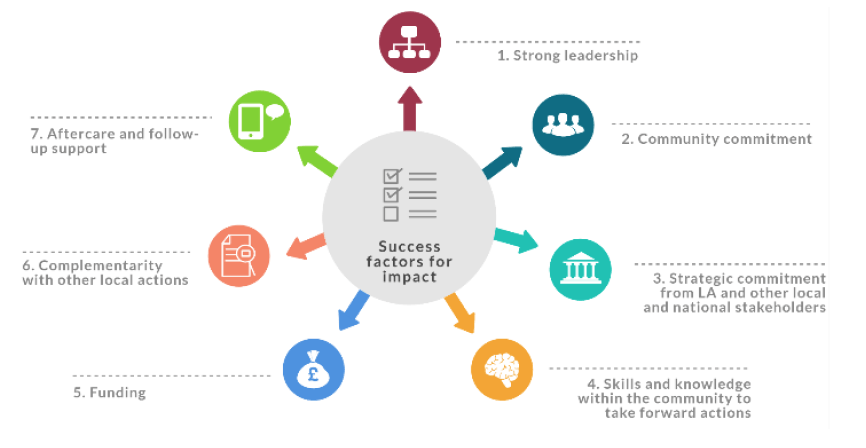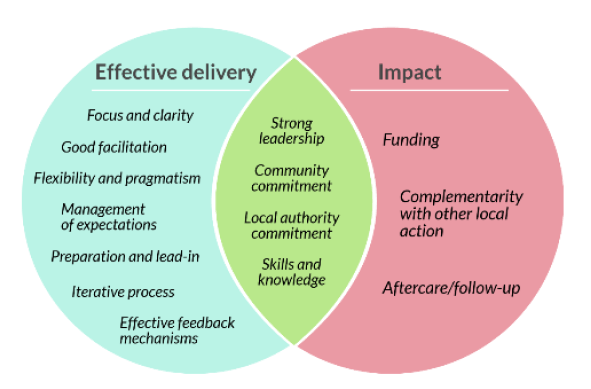Community-led design initiatives: evaluation
Findings from an evaluation of community–led design initiatives funded by the Scottish Government: the Charrette Mainstreaming Programme and the Making Places initiative.
Executive Summary
The Scottish Government set up the Charrette Mainstreaming Programme in 2011, following on from the Charrette Series Pilot in 2010. The Programme was set up to encourage local communities to play a role in the development of their local area by supporting the design process. The Programme has taken on various forms as it has evolved – most recently becoming the Making Places Initiative, which broadened the scope of the programme, and supports local communities to participate in a wider range of participative design events, including smaller-scale events.
Through the Programme, over £1.4 million in funding has been awarded to supporting 78 design events across Scotland between 2011 and 2018. Initially aimed at local authorities and other public bodies, since 2014 the Programme has placed particular emphasis on applications from community and third sector organisations.
The key aims of the Programme at present are to:
- develop an effective method of design which focuses on 'place' and outcomes for local communities
- encourage the mainstreaming of creative design processes in planning and community planning
- place local communities at the centre of the design process; and
- foster collaborative working between public sector organisations and local communities
Scope of the evaluation
In February 2019, Scottish Government commissioned Blake Stevenson Limited working with Watson Burnett Architects to undertake an evaluation of community-led design initiatives.The aims of the evaluation were to:
- assess whether and how the Programme has succeeded in achieving its aims to date
- assess the impact and outcomes of funded design events at a local level
- explore whether/how outputs (e.g. action plans) have been implemented
- create learning about the impact of the Programme that can be used to inform its future development, such as funding decisions
Three key research questions were developed for the evaluation:
- how effective are the design processes in encouraging and empowering local communities' involvement in the design of places?
- what factors influence the implementation of outputs?
- what has been achieved through these design events in terms of longer-term outcomes for communities and partners?
Evaluation methodology
The evaluation involved analysis of data from across all funded projects, in-depth fieldwork with 10 sample projects (involving visits to the projects and interviews with design event organisers, facilitators and participants), a brief literature review, and analysis and reporting.
Key findings
Effectiveness of the design processes in encouraging and empowering local communities' involvement in the design of places
The design events have been generally successful in engaging local people in the design of their local place. Across the sample areas, participation was perceived to be wider than would be usually achieved at community engagement events, with a good cross-section of the community attending. Members of the community and local stakeholders described feeling inspired and empowered by these events and spoke of the events being well facilitated, varied in their approach, inclusive and accessible, as well as suited to participants of all ages. Members of the community also reported feeling that they could actively contribute at these events, with a sense that there were real opportunities to influence future planning and design for their area. Many participants went on to become more actively involved in their community as a result of taking part in the Programme.
This success has not been universal, with some local stakeholders citing other events they had been involved in as less effective. Some of the reasons given for these events being less effective included: weaker facilitation, poorer attendance, and lack of clarity or focus.
Where they worked best, design events gave the community a platform for influencing the design of their local area, and in some instances have led to local authorities embedding community engagement more effectively into their planning processes.
Delivery of events and implementation of outputs
A number of key factors appear to have affected how well the design events themselves were delivered. These included: adequate lead-in time; effective facilitation by independent external providers; clear focus around the purpose of the events; flexibility and pragmatism in relation to what could be achieved; good management of participants' expectations; and an iterative process involving a series of events that gave time in between for ideas to be further developed and then re-visited.
All projects were required to submit a final report to Scottish Government and all did so successfully. These usually described the design event process, priorities agreed by the community, and anticipated future outcomes and impact. Some went as far as to include a precise action plan and timeframe for achievement of outcomes, whereas others were broader in their description of next steps.
Outcomes for communities and partners
All of the sample projects were able to demonstrate achievement of postiive outcomes to varying degrees. Examples of short-term outcomes could be identified across all of the sample projects visited. These commonly included: the creation of new local groups (including some with specific remits for taking forward actions from the design event process), aesthetic improvements to the local area such as painting local landmarks, introducing community activities such as a street market, installing new signage, and developing information materials. These short-term outcomes were important in ensuring momentum was maintained, and were a good way of demonstrating to communities that the design events were leading to action being taken.
Some areas were also highly effective in achieving longer-term outcomes and impact. Examples of some of the longer-term outcomes included: reversing a local authority's decision in relation to the use of a local site; changing a road running through a town centre from dual to single carriageway; developing active travel links; establishing a wellbeing centre; and refurbishing key tourist sites. This type of more substantive impact was often achieved in areas that were already well-served by engaged local people with the skills and knowledge to support development of their area. Other areas, however, were less successful in this respect. This seemed to most commonly have been the result of a lack of engagement by the local authority and other local organisations, apathy within the community, or a lack of skills and capacity within the local community. Key factors for achieving impact are illustrated below in Figure A.
Figure A: Key factors for achieving impact

Key learning points
The evaluation led to a number of learning points being generated:
Learning Point 1: Design events funded through the Programme appear to be a successful method of engaging the community in design of place and their continued use as an approach should be welcomed.
Learning point 2: There are a range of key factors influencing successful delivery of design events, implementation of outputs (e.g. action plans) from the events, and in achieving impact. These are summarised in Figure B below, and could form the basis of guidance to local areas in applying for funding. The factors listed in the overlapping section relate to both delviery and impact.
Figure B. Factors influencing effective delivery and impact

Learning point 3: As part of the process of applying for design event funding, or at latest in the final report produced after the design event, areas should outline at a high level the resources they have available or intend to pursue to fund actions coming out of the design event process. Likewise, the role of key partners, organisations and members of the community in implementation and delivery should be clear. This is more likely to lead to achievement of desired outcomes.
Learning point 4: Ensure timeframes for delivery and production of outputs, including the final reports and action plans from design events, is realistic. Experiences to date suggest that ensuring adequate lead-in time (a minimum of three months), and longer timeframes for delivery are more effective in ensuring a high-quality process is followed, and a high-quality final report is produced.
Learning point 5: National bodies can have an important role in supporting local design events, and the implementation of subsequent action plans, with knowledge, advice and funding. Flexibility and capacity within these organisations to support delivery of local priorities is important.
Learning point 6: Local areas should ensure a realistic budget is set aside for facilitation of design events. While volunteers have an important role to play in the process, over-reliance on volunteers could lead to a reduction in quality.
Learning point 7: Some local areas are well-placed to deliver effective design events that lead to substantive impact. Others have fewer local assets, and in these circumstances more support and capacity needs to be provided by statutory services to enable design events to be delivered successfully and to achieve impact.
Learning point 8: Achieving short-term outcomes has been shown to be critical in empowering and galvanising communities to take action following design events, and in a more sustained way. Setting aside dedicated funding to take forward a number of actions immediately following a design event can be helpful in supporting this.
Learning point 9: While some local areas are well placed to take forward actions following a design event, others are not. A formal follow-up process at regular intervals following the initial design event – potentially at six months, one year and five years – would enable progress to be assessed, reasons for lack of progress to be identified, and the extent to which communities have taken forward actions and local organisations have embedded design event outcomes in their own planning processes to be examined. There may be value in this follow-up support being provided by someone external to the area (e.g. independent facilitators or Scottish Government officials).
Learning point 10: In some places, design events have already become an important catalyst for improving planning and creating a better sense of place. Given the significant impact that design events are having in some areas, there is potential for these to become a more fundamental part of planning processes more widely.
Learning point 11: Design events may have more impact if they are given more formal status – with an expectation or requirement that local authorities and other local bodies reflect the outputs of such events in their local development plans.
Contact
There is a problem
Thanks for your feedback